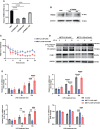METTL3-Mediated N6-Methyladenosine Modification of Trim59 mRNA Protects Against Sepsis-Induced Acute Respiratory Distress Syndrome
- PMID: 35693774
- PMCID: PMC9174697
- DOI: 10.3389/fimmu.2022.897487
METTL3-Mediated N6-Methyladenosine Modification of Trim59 mRNA Protects Against Sepsis-Induced Acute Respiratory Distress Syndrome
Abstract
N6-methyladenosine (m6A) RNA modification is a fundamental determinant of mRNA metabolism in eukaryotic cells and is involved in numerous physiological and pathological processes. However, the specific role of m6A modification in sepsis-induced acute respiratory distress syndrome(ARDS) remains unknown. Here, we show that the levels of m6A RNA were significantly decreased in septic lungs and that METTL3 was the main regulator involved in the absence of m6A RNA modification. Pulmonary endothelial barrier damage is a critical process in the pathogenesis of acute lung injury during sepsis. METTL3 regulated endothelial barrier dysfunction and inflammatory responses in sepsis-induced ARDS in vivo and in vitro. Furthermore, we identified tripartite motif-containing (Trim)59 as a key m6A effector and Trim59 deficiency exacerbated lung injury. Mechanistically, METTL3 inhibited endothelial injury in sepsis-induced ARDS through Trim59-associated NF-κB inactivation. Our findings revealed novel insights into epitranscriptional mechanisms in sepsis-induced ARDS via m6A modifications, which has important application value in the diagnosis, prognosis, and molecular-targeted therapy of sepsis-associated lung injury.
Keywords: METTL3; acute lung injury; endothelial barrier; epigenetic regulation; m6A; sepsis.
Copyright © 2022 Chen, Wu, Zhu, Chen, Xu, Tang, Jiao and Yu.
Conflict of interest statement
The authors declare that the research was conducted in the absence of any commercial or financial relationships that could be construed as a potential conflict of interest.
Figures






Similar articles
-
Histone lactylation-regulated METTL3 promotes ferroptosis via m6A-modification on ACSL4 in sepsis-associated lung injury.Redox Biol. 2024 Aug;74:103194. doi: 10.1016/j.redox.2024.103194. Epub 2024 May 16. Redox Biol. 2024. PMID: 38852200 Free PMC article.
-
N6-methyladenosine writer METTL3 accelerates the sepsis-induced myocardial injury by regulating m6A-dependent ferroptosis.Apoptosis. 2023 Apr;28(3-4):514-524. doi: 10.1007/s10495-022-01808-y. Epub 2023 Jan 16. Apoptosis. 2023. PMID: 36645573
-
METTL3 inhibits hepatic insulin sensitivity via N6-methyladenosine modification of Fasn mRNA and promoting fatty acid metabolism.Biochem Biophys Res Commun. 2019 Oct 8;518(1):120-126. doi: 10.1016/j.bbrc.2019.08.018. Epub 2019 Aug 10. Biochem Biophys Res Commun. 2019. PMID: 31405565
-
METTL3-mediated m6A modification in sepsis: current evidence and future perspectives.Epigenomics. 2025 Jun;17(9):611-623. doi: 10.1080/17501911.2025.2494983. Epub 2025 Apr 19. Epigenomics. 2025. PMID: 40251974 Review.
-
Multifaceted Roles of the N6-Methyladenosine RNA Methyltransferase METTL3 in Cancer and Immune Microenvironment.Biomolecules. 2022 Jul 28;12(8):1042. doi: 10.3390/biom12081042. Biomolecules. 2022. PMID: 36008936 Free PMC article. Review.
Cited by
-
FTO-mediated MMP1 m6A modification promotes osteogenic differentiation of bone marrow mesenchymal stem cells via the ERK pathway in congenital scoliosis.Sci Rep. 2025 Jul 29;15(1):27673. doi: 10.1038/s41598-025-13044-w. Sci Rep. 2025. PMID: 40731128 Free PMC article.
-
WTAP-mediated m6A modification of TRIM22 promotes diabetic nephropathy by inducing mitochondrial dysfunction via ubiquitination of OPA1.Redox Rep. 2024 Dec;29(1):2404794. doi: 10.1080/13510002.2024.2404794. Epub 2024 Sep 23. Redox Rep. 2024. PMID: 39314036 Free PMC article.
-
Novel insights into the regulatory role of N6-methyladenosine methylation modified autophagy in sepsis.Aging (Albany NY). 2023 Dec 18;15(24):15676-15700. doi: 10.18632/aging.205312. Epub 2023 Dec 18. Aging (Albany NY). 2023. PMID: 38112620 Free PMC article.
-
Methylation of TTC4 interaction with HSP70 inhibits pyroptosis in macrophages of sepsis-induced lung injury by NLRP3 inflammation.Am J Cancer Res. 2023 Nov 15;13(11):5122-5137. eCollection 2023. Am J Cancer Res. 2023. PMID: 38058818 Free PMC article.
-
Control of inflammatory lung injury and repair by metabolic signaling in endothelial cells.Curr Opin Hematol. 2025 May 1;32(3):157-167. doi: 10.1097/MOH.0000000000000848. Epub 2024 Oct 25. Curr Opin Hematol. 2025. PMID: 39450949 Review.
References
Publication types
MeSH terms
Substances
LinkOut - more resources
Full Text Sources
Medical

